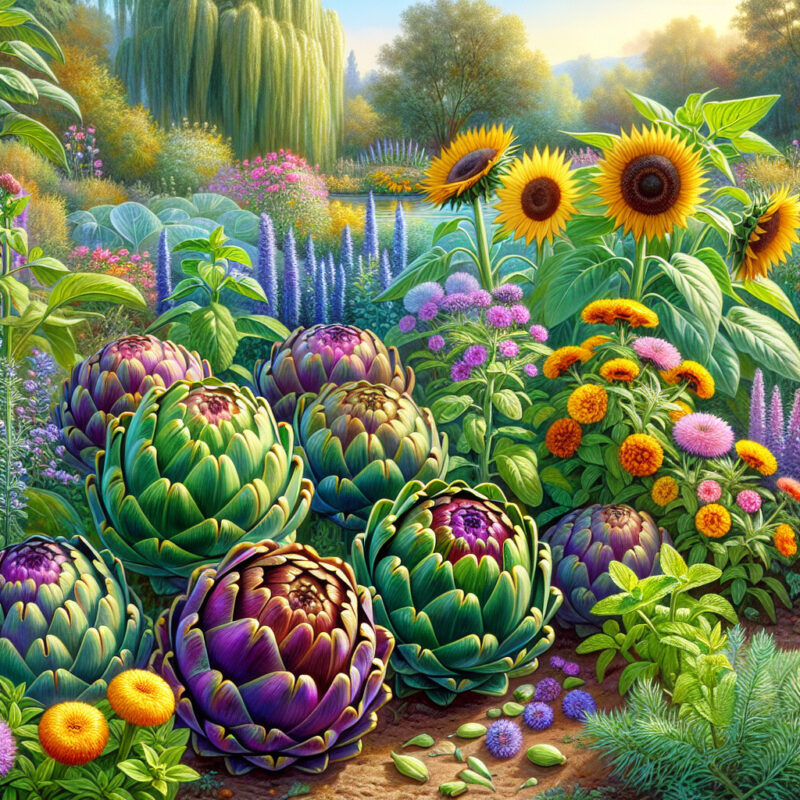Artichokes are not only a delectable addition to any garden, but they also bring with them numerous benefits. Planting artichokes can enhance the visual appeal of your garden while also providing you and your family with a healthy and flavorful vegetable. However, to optimize the growth and success of your artichoke plants, it is essential to carefully consider the companions you choose to plant alongside them. By selecting suitable companions, you can create a harmonious environment that promotes growth, deters pests, and maximizes your garden’s yield. In this article, we will explore various options for what to plant with artichokes, ensuring your garden is brimming with vitality and productivity. So let’s dive in!
key Takeaways
- Artichokes thrive when planted with companion plants such as tarragon, chives, and marigolds.
- Planting certain herbs like mint and fennel near artichokes can inhibit their growth and should be avoided.
- Beans and peas can be beneficial to artichokes by fixing nitrogen in the soil.
- Since artichokes are tall plants, it is important to choose companion plants that do not overshadow or crowd them.
- Companion planting can help deter pests and attract beneficial insects to the artichoke garden.
- Planting artichokes near tomatoes and cucumbers can result in competition for nutrients and should be avoided.
- Companion plants like yarrow and borage can attract pollinators, which aid in artichoke fruit production.
- Artichokes can benefit from the shade provided by companion plants like flax and chard.
- Using companion planting techniques can enhance the overall health and productivity of artichoke plants.
Companion Planting for Artichokes
What to Plant with Artichokes
When it comes to planting artichokes, choosing the right companion plants can help improve growth, deter pests, and enhance the overall health of your garden. Here are some plants that can thrive alongside artichokes:
1. Garlic
Garlic is a great companion plant for artichokes. Its strong scent repels many pests, including aphids and spider mites, which can damage artichoke plants. Additionally, garlic has natural fungicidal properties that can help protect artichokes from diseases.
2. Chives
Chives are another excellent companion for artichokes. Their purple flowers attract beneficial insects like bees, which can aid in pollination. Chives also have natural pest-repellent properties, helping to keep common artichoke pests at bay.
3. Tarragon
Tarragon is a perennial herb that can benefit artichokes in multiple ways. It attracts predatory insects like ladybugs and lacewings, which feed on pests like aphids and caterpillars. Tarragon also improves the flavor of artichokes when they are cooked together.
4. Nasturtiums
Nasturtiums are known for their vibrant flowers and edible leaves. Planting these colorful flowers near artichokes can act as a natural trap crop, attracting pests away from the artichoke plants. Additionally, nasturtiums have a peppery taste that can serve as a natural deterrent to certain pests.
5. Yarrow
Yarrow is a hardy perennial flower that can complement artichokes aesthetically and functionally. Its feathery leaves and delicate flowers add beauty to the garden, while also attracting hoverflies and ladybugs, which feed on aphids and other artichoke pests.
6. Borage
Borage is a versatile companion plant for artichokes. Its attractive blue flowers attract pollinators, while its leaves release chemicals that repel pests like tomato hornworms. Borage can also help improve the overall health and flavor of neighboring artichoke plants.
7. Dill
Planting dill near artichokes can be beneficial for both plants. Dill attracts beneficial insects like wasps, which prey on caterpillars and other pests that may harm artichokes. Additionally, dill can enhance the flavor of artichokes when used together in culinary dishes.
8. Marigolds
Marigolds are well-known companion plants for various crops, including artichokes. Their strong scent deters many pests, including nematodes and aphids. Planting marigolds around artichokes can provide natural pest control, as well as add a pop of color to your garden.
Conclusion
Frequently Asked Questions
What are some good companion plants for artichokes?
Some good companion plants for artichokes include tomatoes, potatoes, spinach, and peas. These plants provide various benefits to the artichokes, such as reducing weeds, attracting beneficial insects, and providing shade.
Can I plant artichokes near other edible plants?
Yes, artichokes can be planted near other edible plants. However, it’s important to consider the spacing requirements and growth habits of both the artichokes and the neighboring plants to ensure they have enough room to grow and thrive. It’s also recommended to plant artichokes in an area where they won’t shade other plants too much, as they can create a dense canopy.
How much space do artichokes need?
Artichokes require ample space to grow properly. It’s recommended to provide each artichoke plant with about 3-4 feet of space in all directions. This allows the plants to develop a strong root system and reach their full size without competing with neighboring plants for resources. Maintaining adequate spacing also helps with air circulation, reducing the risk of diseases.
When is the best time to plant artichokes?
The best time to plant artichokes is in early spring, after the danger of frost has passed. This allows the plants to establish themselves before the summer heat. However, if you live in a mild climate, artichokes can also be planted in the fall.
How long does it take for artichokes to mature?
Artichokes typically take around 85-100 days to mature from the date of planting. However, this can vary depending on the variety and growing conditions. Harvest time for artichokes is usually in late spring or early summer.
Growing Flowers for Butterfly Gardens
Choosing the Right Flowers for a Butterfly Garden
Butterfly gardens provide a beautiful habitat for these delicate creatures and often attract a variety of different butterfly species. When choosing flowers for a butterfly garden, it’s essential to select those that are rich in nectar and provide ample landing surfaces for butterflies. Some popular flower choices include milkweed, butterfly bush, zinnias, coneflowers, and black-eyed Susans. These flowers not only provide a source of food for butterflies but also offer vibrant colors that enhance the beauty of the garden.
Creating a Suitable Environment
In addition to selecting the right flowers, creating a suitable environment is crucial for attracting butterflies to the garden. Butterflies require sunlight for warmth, so it’s important to choose a sunny location. Providing a water source such as a shallow dish with pebbles or a birdbath can also help attract butterflies. To encourage butterflies to stay and reproduce, it’s beneficial to incorporate host plants into the garden. Host plants are species that butterflies lay their eggs on, and when the eggs hatch, the caterpillars have a reliable food source. Some examples of host plants include milkweed for monarch butterflies, dill for swallowtails, and parsley for black swallowtails.
Final Thoughts
In conclusion, knowing what to plant with artichokes is essential for a successful garden. Companion plants, such as tomatoes and spinach, can enhance the growth and health of artichokes. Adequate spacing, planting at the right time, and understanding the maturation process are important factors to consider when growing artichokes. By following these guidelines, you can enjoy a bountiful harvest of artichokes in your own backyard garden.
Additionally, creating a butterfly garden can be a rewarding endeavor. Choosing the right flowers and creating a suitable environment can attract a variety of butterfly species and provide them with a habitat they need. By incorporating colorful and nectar-rich flowers into your garden, you can enjoy the beauty of butterflies fluttering around while supporting their population. Incorporating host plants further enhances the butterfly garden by providing a food source for caterpillars. With careful planning and proper care, you can create a stunning and vibrant butterfly garden that brings joy and benefits to both you and the butterflies.

